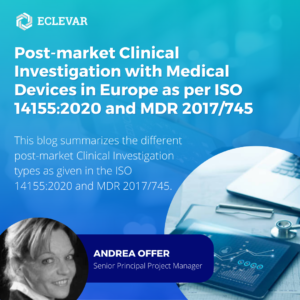Post-market Clinical Investigation with Medical Devices in Europe as per ISO 14155:2020 and MDR 2017/745
Introduction
This blog summarizes the different post-market Clinical Investigation types as given in the ISO 14155:2020 and MDR 2017/745.
Post-market Clinical Investigations as per ISO 14155:2020
As per ISO 14155:2020 Annex I, section I.2.3, a post-market clinical investigation is:
- “A clinical investigation carried out following market approval of a medical device, intended to answer specific questions relating to clinical performance, effectiveness or safety of a medical device when used in accordance with its approved labelling.”
- “If marketed medical devices are being investigated for new indications, other than described in the approved labelling, requirements for pre-market clinical investigations apply.”
Clinical investigations at the post-market stage can be confirmatory and interventional or observational and non-interventional. Observational clinical investigations may collect prospective or retrospective data. An example of the confirmatory, interventional post-market clinical investigation is the PMCF clinical investigation as per Art. 74 (1) MDR 2017/745.
With post-market clinical investigations, data of a broader subject population, the real-world use, long-term outcomes, or rare adverse events can be investigated.
What needs to be considered for non-interventional clinical investigations, like registries, observational studies, or survey studies, is the non-interventional assignment process to a device.
While for interventional studies, often the gold standard is a randomized controlled trial (RCT), the decision on the treatment is already done by the physician, and the patient will only be asked to participate in the clinical investigation based on the treatment.
Confirmatory Clinical Investigation
A confirmatory clinical investigation is “an adequately controlled clinical investigation in which the hypotheses of the primary endpoint(s) are stated before the start of the clinical investigation in the CIP and are analysed by the CIP (i.e. sound confirmative statistical testing is pre-specified, intended, and applied).”
Link to MDR 2017/745 Articles
The principle of ISO 14155:2020 Annex I post-market stage applies to clinical investigations as per MDR 2017/745 Article 74.1 PMCF clinical investigations and the Art. 82 other clinical investigations
- Article 74.1 PMCF clinical investigations fall under the post-market stage, although the confirmatory design and interventional aspects need to be taken into account for planning these studies also
- Article 82: Requirements regarding other clinical investigations, if:
- It is an interventional clinical investigation with a CE-marked or non-CE marked device, but not for purposes of Art. 62.1 (example: CE marked Stent, investigation to explore the impact on blood flow; non-CE marked smart monitoring device, investigation to explore changes in the behavior of subjects when using the device)
- clinical investigations with CE-marked devices, within the scope of intended use and without any additional burden to the subject fall under the post-market stage (observational)
- clinical investigations with CE-marked devices, within the scope of intended use, without any additional burden to the subject, but not for safety and performance would be post-market stage (observational), but are out of scope of the MDR 2017/745. This does not imply that they are out of scope of the national regulations of a Member State as well.
Submission of the notification or application of the Clinical Investigation
Since the MDR 2017/745 focuses on submissions to the Competent Authority of the EU Member States, the requirements for the submissions to the Ethics Committees are regulated via the Member States’ national laws, and it is recommended to check the respective EC website for advice.
With a rough categorization, it would be two types of post-market clinical investigations: CIs per Art. 74(1) and per Art. 82. These would lay down the criteria for the route of submission:
Application Type | CI | Description of CI |
Notification: | Article 74 (1): | Clinical investigations regarding devices bearing the CE marking – within the scope of its intended purpose, additional procedures are invasive or burdensome |
EC and CA submission as per national Requirements: | Article 82: | Requirements regarding other clinical investigations |
While it is a clear notification process For PMCF clinical investigations as per Art. 74 (1), for Art. 82 studies, it depends not only on national requirements but also on the objectives of a clinical investigation. In some countries, the submission of a notification is required, while in other countries, for Art. 82 other clinical investigations, a submission of an application is mandatory. This is summarized in the figure below:
| Study per MDR Art. | Class of device | Regulatory status of device | Submission type |
| 74.1 | I through III | CE-marked, additional burdensome or invasive, for indications in Art. 62.1 | Notification 30 days prior to commencement of study, positive opinion from an EC included |
| Art.82 | I through III | CE-marked, observational, not additional burdensome or invasive | As per EU Country requirements |
| Art.82 | I through III | Non-CE marked, novel device, not for indications in Art. 62.1 | As per EU Country requirements |
| Art.82 | I through III | CE-marked, not for indications in Art. 62.1 | As per EU Country requirements |
Documents required to support a submission are listed in Annex XV MDR 745/2017, and further explained in the MDCG 2020-8 guidance.
SAE Reporting:
SAE reporting requirements for clinical investigations are laid down in Art. 80 MDR 2017/745. The MDCG 2020-10/1 and the reporting form MDCG 2020-10/2, the MDCG provide clarification on the requirements. The MDR 2017/745 and the MDCG 2020-10 focus on the requirements for Competent Authority Reporting. Reporting obligations to the Ethics Committees (ECs), or other boards, are regulated by the Member States. It is recommended to check the national laws and the EC websites for additional obligations.
For Post Market Clinical Follow-Up Studies with CE- marked devices, falling into the scope of Article 74 (1) MDR 2017/745, Article 80 (6) applies for SAE reporting, and Article 80 (5) refers to Vigilance Reporting for Manufacturer as of Articles 87 to 89 and 92 MDR 2017/745.
| Article | Requirements |
| 80 (5) | In te case of PMCF investigations referred to in ARticle 74(1), the provisions on vigilance laid down in Articles 87 to 90 and in the acts adopted pursuant to Article 91 shall apply instead of this Article |
| 80 (6) | Notwithstanding paragraph 5, this article shall apply where a causal relationship between the serious adverse event and the precedeing investigational procedure has been established |
| Note: Sentence (79) | (79) The reporting of serious adverse events or device deficiencies during clinical investigations and the reporting of serious incidents occuring after a device has been placed on the market should be clearly distinguished to avoid double reporting |
For Clinical Investigations as per Art. 82 MDR 2017/745, SAE reporting requirements are regulated by the Member States. It therefore requires checking the national law for reporting obligations to CA, EC, and other boards. With CE-marked devices, Vigilance Reporting requirements as per MDR 2017/745 apply.
Investigator Reporting applies as outlined for Clinical Investigations per Art. 80, national requirements, taking into account the Declaration of Helsinki
References
- ISO 14155:2020 Clinical investigation of medical devices for human subjects — Good clinical practice
- WMA DECLARATION OF HELSINKI – ETHICAL PRINCIPLES FOR MEDICAL RESEARCH INVOLVING HUMAN SUBJECTS
- REGULATION (EU) 2017/745 OF THE EUROPEAN PARLIAMENT AND OF THE COUNCIL of 5 April 2017 on medical devices, amending Directive 2001/83/EC, Regulation (EC) No 178/2002 and Regulation (EC) No 1223/2009 and repealing Council Directives 90/385/EEC and 93/42/EEC
- MDCG 2021-6: Regulation (EU) 2017/745 – Questions & Answers regarding clinical investigation, April 2021
- MDCG 2020-10-1 Guidance on safety reporting in clinical investigations, and MDCG 2020-10-2 Clinical Investigation Summary Safety Report Form v1.0.
- MDCG 2021-08 Clinical investigation application/notification documents.
- MDCG 2021-28 Substantial modification of clinical investigation under Medical Device Regulation
- MDCG 2021-20 Instructions for generating CIV-ID for MDR Clinical Investigations.
Thank you for your time, and interest. ECLEVAR MedTech posts regularly on topics related to Medical Devices and IVDs – Regulatory, Clinical, Medical Writing, in Australia, the EU, the UK, and the USA.
Check-out for our next interesting blog.
ECLEVAR MEDTECH is a global CRO, headquartered in Paris. We support medical device and IVD manufacturers in the MDR and IVDR transition. Our team works as an extension team of medical affairs and regulatory affairs sponsors. We offer customized service, personalized to the need of our clients. Whether you are looking for a full-service CRO or staffing clinical or regulatory experts, our management team with more than 20 years of experience will drive you to an effective solution.
Please contact us at clientcare@eclevar.com to learn more.

